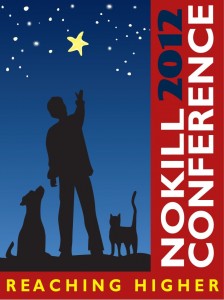Yesterday I live-tweeted the talks I attended. Today I will liveblog. The panel includes Kelly Jedlicki, Larry Tucker, Peter Masloch, and Michael Kitkoski and is moderated by Nathan Winograd.

First, a brief intro by NW: Why do shelters kill? Basically, it cones down to failure. Failure of accountability, failure of care, etc. Shelters blame the public for failure to s-n or failure to be responsible.
At HSUS Expo a few years ago, a national “expert” denied that shelters killed-actually said that they are not killing when the “take their life”, “humanely, destroy” (she could barely get the last word out–NW played a tape of the quote), etc Denial and blame the public underlie the sustained killing paradigm.
We are living the movie Groundhog Day–the story is the same, though the names of people and places change. Wherever there is killing, there are directors who refuse to change, national organizations that defend the killing and the shelter, and ordinary people who need to take up the fight whether they like it or not. The keys are available to everyone. We have known how to do this for over 10 years.
Your info packets have guides to advocacy, No Kill economics and other aspects of No Kill.
Panelists: Kelly Jedlicki of Shelby Co KY No Kill Mission–95%+ save rate for dogs and cats. Larry Tucker from Austin, former Chair of Austin Commission, fought for NK, including the ASPCA. Peter Masloch walked into the Allegheny Co MD Shelter and said “There will be no more killing in the shelter!” One year later they are saving over 90%. Michael kitkoski of Rockwall Pets saw the shelter was not doing it’s job. Did marketing, adoptions, achieving 95%+ save rates.
Self-Intros:
MK: We are shape-shifters, started as a couple of naive volunteers who wanted to help. Had 501c3. After taking the same few dogs to Petco every week and seeing all the empty cages, he realized they were killing most of the dogs, not even trying. Asked for a month of no killing and he’d take responsibility for failure–96% save rate. Shelter is now privatized (after a fight which the shelter started) and required by contract to be No Kill.
LT: Was chair of Animal Advisory Commission. In TX, cities beyond a certain size are required to have such commissions. Had to ask City Council to expand their scope when.
PM: Founded organization after his famous statement. Didn’t even know about NW when he started, but soon found out. Started NK Allegheny Counted. Organization is growing.
KJ: Took a different approach–saw email pleas as a volunteer. Approached County saying “look what I can do for you”. Rural area NK Mission is small group of about 20 volunteers. The group fills in the gaps not covered by the shelter–spay-neuter, offsites. They are the workhorses and all have full-time jobs.
Q&A
NW TO MK: The most important thing a shelter can do to stop killing is adoptions, and that is what your group did. How would someone go about doing what you did?
A recent newspaper article said that 74% of people don’t want tax dollars used for killing animals. The shelter was annoyed about our referring adopters to the shelter. We did offsites and increased adoptions. We found a back door.
How did you partner /someone hostile–you did their job and they didn’t appreciate it and even filed harassment suits against you?
They became afraid of us, oddly enough. Afraid of publicity.
NW to LT: Why should everyone create a NK Plan like Austin? How did you get the AA Commission to be NK?
Lightning rod moment was when shelter said feral cats should not be relocated –too stressful, even from a construction site that was going to be blasted!
Shelter Director complained about ads for pet adoption–too many ppl came in to adopt–took too much employee time! I decided to run ads weekly rather than monthly.
Passing a moratorium on empty cage killing was a pivotal moment. Getting the Commission to No kill was a Battle Royale. ASPCA and other pro-kill types wanted seats on the Commission. The council would not utter the term No Kill.
Candidate forums were key. It was a huge fight.
NW to LT; What advice do you have for ppl in an apparently hopeless situation?
Never stop. Have many meetings. Brainstorm. have frequent meetings. Run full-page ads (standby rates) they are expensive but essential. Reject defeat. Change course when necessary. The ASPCA opposition was enormous. NW did a lot of work behind the scenes.
NW: I admit that I like to fight.
LT: ASPCA sent high level speakers to say that NK was a threat to success. We gave shelter director many opportunities to get on board. As she was about to be fired, she finally admitted that NK was working, and that she wanted to quit when the killing moratorium was initially passed.
We had weekly public meetings. We had to prove that it would work. Not just that we thought it would work. had to compile report about places like Reno with NK success (available at City of Austin website).
Once the shelter director was fired, success was immediate.
NW to PM How did you do it? they didn’t just listen to you when you walked in and said the killing must stop.
It was a typical rural shelter–off in the woods, no published stats,l most staff was on leave for some reason or other. What I read about it was against my morals. we told County we could take over operations, naively. Went in back to a small room. Shelter was designed to kill not care for animals. Small room was “euthanasia room”. I decided we didn’t need that. Got rid of that big table to make space for cats, also got rid of office furniture to make room for cats. Who has time to sit anyway? volunteer numbers grew. Had no manager Nov 2012-Apr 2011. Needed to partner with other groups. brought animals to vet, much to vet’s surprise–old shelter never brought animals in.
Community support was great–ppl donated food and cleaning supplies. We did not plan ahead. We kept it going. We did not know how to run a shelter. just cared for the animals.
NW to PM: You had opponents, including thew local Humane Society, and ppl who testified against saving animals at commission meetings. How did you deal with them?
I sat down with the new Commissioner and talked with him about the NKE and what we were trying to do. He said it was great. I didn’t trust him at first, but found that he meant it. I gave 5 min report at the weekly commission meeting. Some ppl did not like that but the commissioners didn’t listen to them. They knew that the public was behind saving animals.
NW to KJ: you work full-time and live in a different county and commute to the shelter. How did you manage to do this?
I started out volunteering for a limited admission HS and getting email pleas. At the county shelter, cats were housed singly unvetted. sick and injured animals were killed. Few animals were rescued. Director held many titles –fire chief, EMS, judge etc-not at shelter.
What to do? Read Redemption, which made sense. Was on HS Board. Approached them with her idea, approached the senior ACO and he skimmed it. Approached Shelter Director with plan. SCNKM would be under HS, would do all the work. Rely on donations. Wouldn’t cost County anything, would improve County image. They wet for it.
Got blindsided at HS Board meeting–they wanted to put SKNKM “on hold” becasue they wanted to build a sanctuary and did not want to compete for funds. I moved to break from the HS–motion approved. What had I done? People stepped up–Tompkins County webmaster built a website, others did other things. Got rid of “blue room”. Office is now mother/baby kitten room. Now lobbying to make one of the bathrooms into animal housing.
Audience Q&A
What if it isn’t the shelter director that is your problem, what if it is the mayor or some other higher-up?
LT: The movie Schindler’s List comes to mind. Schindler wanted to appear powerful–didn’t yet have agenda of saving lives–made himself known to powerful people. I’d talk to important people–small talk without an agenda and follow up with an email mentioning that I wanted to get on Animal Advisory Commission.
NW In Austin, there was a good cop and a bad cop. Larry was the good cop–offered to get FixAustin and critics off their back.
How do you deal with a nonprofit that is not required by contract but does take in and kill cats? The guy in charge is a national figure.
MK: Look for a back door. Would they let someone pull cats?
KJ: Who donates to them? Do those ppl know what is going on.
LT: Take the Feral Freedom model to the media.
NW: Use paid advertising to get the word out if they aren’t picking up your press releases. you can influence public opinion another way–a “Lover’s List”– people of influence and affluence–clerks, aides, elected officials, local celebrities, movers and shakers. Once or twice a year, send them a short (2 pages max) white paper explaining the situation. Do not ask permission. Do not ask for money. Just send it. Give them something to talk about on the golf links, etc.
What happens when you are getting stonewalled when you try collaboration? When do you start to fight?
MK: use your instincts. At a certain point you will have a community behind you. What we did wrong was have Rockwall Pets do everything. When we criticized, we got backlash. You need someone separate to fight. Austin did it right.
What about LA County?
NW; No Kill LA is a marketing scam–a way to kick the can down the field. It doesn’t take 5 years. it can be frustrating if the kill rate goes down but slowly. NYC is making no progress. Where do you focus your energy? 10 years is not acceptable. What is the day-to-day plan. LA is on its 3rd 5 year plan.
What is you opinion of limited admission shelters?
NW I focus on reforming animal control.
What if you have an incompetent director and volunteers arepersecuted for speaking up?
PM; go to the media.
NW: It is illegal for a shelter to retaliate against volunteers and rescues–it violates your constitutional rights. See the document ‘Section 1983 to the rescue”. You can sue the county and the shelter director as an individual. The Guide in your packet “The NK revolution starts with you” has step-by-step strategies for reforming animal control. The biggest failure in reforming AC is expecting it to be easier than it will be and giving up too soon.
What if your group’s lawyers tell you not to get involved in politics?
NW: You don’t need a group. You have the right to freedom of assembly. You can start a new group, get letterhead, etc. and lobby for change.
Maryland recently had a dangerous BSL ruling. How do you deal with BSL?
PM: We were told we can’t adopt out pit bulls. We are hoping that the House will reverse the ruling.
NW: To each speaker. State one key lesson.
MK: We were stupid and you can only be naive once. It can be a good thing. Please do not keep your mouth shut. We are now consulting with nearby counties and they are saving 80% and improving. Get the ball rolling. IN OUR LIFETIMES, WE WILL BE A NO KILL NATION!
LT: We spent way too much time on collaboration. We thought the ASPCA might come on board, that their leader might have a soul. We didn’t listen to Nathan at first when he said it would be a fight. It was a huge fight.
PM: Never give up. you may become the most hated person in your community, but it is a matter of life and death.
NW; Would you re-create that moment?
PM: (stands) THERE WILL BE NO MORE KILLING IN THE SHELTER!
KJ; One person can make a difference. I never thought that I would do this. You need to toot your horn. Have people out front tooting your horn.
NW: The session is officially over, but the speakers are hostage to your questions.
What if the mayor and city officials take credit for the work of the volunteers and rescues and the media takes their side and they don’t want to be told what to do?
LT: That happened in Austin–ASPCA leader was promoted based on Austin success! Media is different today. A wel-written keyword-optimized press release can be picked up by bloggers.
NW: there is also tabling, lover’s list, etc.
How do you combat lies, like when a shelter claims that it’s 73% kill rate is for “medial reasons”?
LT: Our ordinance defined the medical reasons.
KJ: We tell the public about the animals we treat, and explain to people that you don’t see amputees, ringworm etc at other shelters because they just kill them.
My shelter has no SOP, and I’ve gone over heads to talk to ACO’s supervisors, elected officials to get input into writing SOP, should ACO be able to writ it herself?
NW: Not a conflict of interest to have ACO write manual. There should be public input. An Animal Advisory Commission like Austin would be a good start.
What more can my coalition be doing to advance No Kill?
NW: You need to take the issue to the politicians, hold them accountable for abuses and killing at the shelter. Make it a political issue and get the media interested in the story. If you say the media isn’t interested, you are doing it wrong. They need to sell papers. Scandals sell papers.
Is it better for the shelter to report directly to the mayor or through another department.
PM: It is different in different communities.
NW: I differ. If a shelter is under Health, they will view animals as a health risk. Under Police, dogs are viewed as a public safety risk. Under Sanitation, they are treated like trash. While not a panacea, it is better if they are a separate department.
LT: To project a new image to the public we changed ACO to Animal Protection Officer, changed the logos, etc.
I understand that we need to project a professional image, but some of our group get emotional and make outrageous statements.
NW: Don’t be in that group. Be the rational one. Be the good cop who offers to get the crazies off the officials’ backs.























